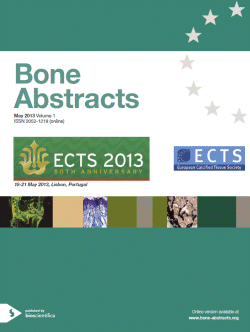
European Calcified Tissue Society Congress 2013
Lisbon,
Portugal
18 May 2013 - 22 May 2013

Poster Presentations
Paediatric bone disease
ba0001pp502 | Paediatric bone disease | ECTS2013
Craniofacial consequences of high-dose zoledronic acid injections in onco-pediatric patients
Lezot Frederic , Chesneau Julie , Battaglia Severine , Brion Regis , Farges Jean-Christophe , Lescaille Geraldine , Castaneda Beatriz , Marec-Berard Perrine , Brugieres Laurence , Corradini Nadege , Heymann Dominique , Redini Francoise
ba0001pp503 | Paediatric bone disease | ECTS2013
High dickkopf-1 levels in sera and leukocytes from children with 21-hydroxylase deficiency on chronic glucocorticoid treatment
Brunetti Giacomina , Maria Felicia Faienza , Piacente Laura , Ventura Annamaria , Oranger Angela , Carbone Claudia , Benedetto Adriana Di , Colaianni Graziana , Mori Giorgio , Colucci Silvia , Cavallo Luciano , Grano Maria
ba0001pp504 | Paediatric bone disease | ECTS2013
The serum levels of carboxylated and undercarboxylated osteocalcin in children with cystic fibrosis
Ambroszkiewicz Jadwiga , Sands Dorota , Gajewska Joanna , Chelchowska Magdalena , Laskowska-Klita Teresa
ba0001pp505 | Paediatric bone disease | ECTS2013
Associations between leptin, growth factors and bone turnover markers in prepubertal obese children
Gajewska Joanna , Ambroszkiewicz Jadwiga , Chelchowska Magdalena , Klemarczyk Witold , Kurpinska Patrycja , Weker Halina , Laskowska-Klita Teresa
ba0001pp506 | Paediatric bone disease | ECTS2013
Body composition in 3- and 4-year-old preterm and full-term infants – preliminary data
Karczmarewicz Elzbieta , Czekuc-Kryskiewicz Edyta , Czech-Kowalska Justyna , Jaworski Maciej , Pludowski Pawel , Bulsiewicz Dorota , Kornacka Maria , Niezgoda Anna , Pleskaczynska Agata , Nowakowska-Rysz Monika , Dobrzanska Anna , Lorenc Roman
ba0001pp507 | Paediatric bone disease | ECTS2013
Perceived activity capability in children and adolescents with osteogenesis imperfecta
Hagberg Maud , Lowing Kristina , Astrom Eva
ba0001pp508 | Paediatric bone disease | ECTS2013
Comparison of the bone densitometry and anthropometric parameters between the Ukrainian, Indian and Nigerian young male students, graduated in Lugansk State Medical University
Luzin V , Stklyanina L , Ushko Y , Ignatyev A



